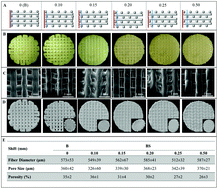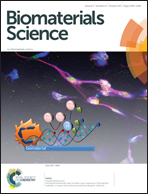3D printed poly(ε-caprolactone) scaffolds modified with hydroxyapatite and poly(propylene fumarate) and their effects on the healing of rabbit femur defects†
Abstract
A large variety of approaches have been used to treat large and irregular shaped bone defects with less than optimal success due to material or design issues. In recent years patient specific constructs prepared by additive manufacturing provided a solution to the need for shaping implants to fit irregular defects in the surgery theater. In this study, cylindrical disks of poly(ε-caprolactone) (PCL) were printed by fused deposition modeling and modified with nanohydroxyapatite (HAp) and poly(propylene fumarate) (PPF) to create a mechanically strong implant with well-defined pore size and porosity, controllable surface hydrophilicity (with PPF) and osteoconductivity (with HAp). Cytotoxicity, irritation and inflammation tests demonstrated that the scaffolds were biocompatible. PCL/HAp and PCL/HAp/PPF scaffolds were implanted in the femurs of rabbits with and without seeding with rabbit Bone Marrow Stem Cells (BMSC) and examined after 4 and 8 weeks with micro-CT, mechanically and histologically. BMSC seeded PCL/HAp/PPF scaffolds showed improved tissue regeneration as determined by bone mineral density and micro-CT. Compressive and tension stiffness values (394 and 463 N mm−1) were significantly higher than those of the healthy rabbit femur (316 and 392 N mm−1, respectively) after 8 weeks of implantation. These 3D implants have great potential for patient-specific bone defect treatments.



 Please wait while we load your content...
Please wait while we load your content...